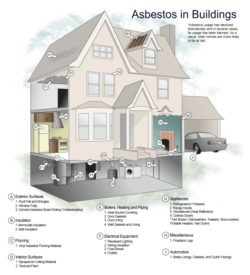Our Services
 A new duty to manage asbestos has been added to the Control of Asbestos at Work Regulations. It will apply to you if you have maintenance and repair responsibilities for non-domestic premises either through a contract or tenancy agreement or because you own the property. The Asbestos Group is a well-established company specialising in the areas of:
A new duty to manage asbestos has been added to the Control of Asbestos at Work Regulations. It will apply to you if you have maintenance and repair responsibilities for non-domestic premises either through a contract or tenancy agreement or because you own the property. The Asbestos Group is a well-established company specialising in the areas of:
- Asbestos Surveying
- Asbestos Risk Assessment
- Asbestos Management Plans
- Re-inspections
- Non Notifiable Licensed Work (NNLW)
- Asbestos Recognition and Determination
- Asbestos Management Software
- Non Licensed Removal
- Project Management
- Asbestos Management Training
- Asbestos Awareness Training both online and face to face
We offer independent, specialist surveyors who are fully qualified and offer the perfect solution to assist you with your ‘Duty to Manage Asbestos in the Premises’ on a national level.
Information for the duty holder
Duty holder’s planning
The duty holder needs to consider the purpose of the survey and what information it needs to provide. The duty holder will be the client and should consider:
- Why the survey is needed?
- What type(s) of survey is needed?
- What information must the survey provide?
- What format do I want the report in (asbestos register, drawings, electronic,
printed etc)? - What information will the surveyor require?
Duty holder’s use of survey information
The survey report needs to meet the requirements of the client and comply with the tender/contractual obligations. The report should be fit for purpose and the client should check that this is the case. Therefore, the client should examine the report and carry out a number of checks to make sure that the survey has been adequate and that the report is suitable and accurate. These checks are set out below.
What the duty holder should do to check the accuracy of the survey report;
- Check the report against the original tender.
- Check for unagreed caveats or disclaimers.
- Check that the survey is as requested: Management or refurbishment/
demolition (or a combination). - Check diagrams and plans are clear and accurate.
- Check all rooms and areas have been accessed
- Check sufficient samples have been taken (usually 1–2 per area/room) and
that sample numbers are not disproportionate (e.g. dominated by one ACM type). - Check sample numbers reflect variations in the same ACMs, e.g. different
ceiling tiles in the same room. - Check for any obvious discrepancies and inconsistencies.
The information in the survey report should be used to form the asbestos register which is a key component of the management plan. The survey report itself will generally not be the asbestos register. The asbestos register will be a simpler document and will not contain most of the information in the survey report, e.g. the bulk analysis results or survey site information. However, the results in the survey report should be presented in a manner or format that can be directly lifted or employed to form the asbestos register.
The asbestos register is a living document which must always contain current information on the presence and condition of asbestos. The register will need regular updating.
The duty holder should make:
- Deletions to the register when asbestos is removed.
- Additions to the register when new areas are sampled.
- Changes to the register if the condition of ACMs has altered on re-inspection.
The asbestos register can be a paper or electronic document/database. It must be up to date and accessible, irrespective of the form. Hard copies are useful for ease of interrogation and may suit duty holders with smaller and simpler premises. Electronic versions are often more convenient for duty holders with large numbers of properties. Electronic documents can be readily accessible and easily updated. Electronic documents can also be used to record all the remedial work carried out and to prompt the relevant person, e.g. the building manager, to carry out and record any further inspections required. Some databases can also link digital picture images of a sample and CAD plans. Printed versions of an electronic document will usually be needed for contractors and others. The distribution and circulation of such documents will need to be carefully managed to ensure only current versions are referenced.
The Asbestos Group’s surveying techniques meet all HSG264 requirements and all samples are sent to UKAS (United Kingdom Accreditation Service) accredited laboratories for independent impartial analysis, providing you with best possible service and results.

